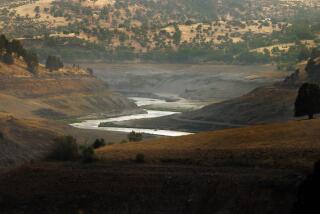Editorial: California is dammed enough already
Environmental consequences aside, it would seem to make a certain amount of sense to dam a river in order to store and distribute water where and when it is most needed.
But what if there’s no river? Or more to the point, what if every river that can be dammed already has been dammed, and the water in those rivers has already been tapped? The value of new, giant dams is extremely limited and costly without new giant rivers to fill them, and California has no such new rivers.
That’s the gist of the situation that faces the California Water Commission, which meets for three days this week to consider how to spend billions of dollars in Proposition 1 bond funding on storage projects — including its staff’s recommendations against huge new dams.
Commissioners should pay heed to their experts and reject projects that are designed for a different era, before the development of more deft and cost-effective technologies and water management practices.
Voters adopted the water bond in 2014, in the midst of a deep drought that may well have become California’s new normal. The $7.12-billion measure allocated $2.7 billion for water storage projects that would in some way make up for the shrinking of the Sierra snowpack, which has for decades provided much of the water that sustained streams and wetlands and supplied farms and urban faucets.
Creating more traditional reservoir storage does little to ease water shortages for most Californians.
The wording of the bond was carefully negotiated so that various interests could fight later over whether the funding was meant for huge structures like the nation’s tallest dam (Oroville, built in the 1960s), or alternatives to dams, designed and built for a dry era with diminished flow. The commission is the arena for that battle.
The San Joaquin River is already so dammed and diverted that it runs dry in its central stretches most years, yet there is an application for bond funding to add yet another dam, known as Temperance Flat. Meanwhile, backers of the Sites Project want a dam to capture water diverted away from the Sacramento River.
Reservoirs created by either project could be filled only by a succession of unusually heavy storm seasons — and then would be quickly drained by water-rights holders (typically farmers) who have legal claims to every drop. California can hardly count on such excess and would be foolish to allocate its storage resources to such projects.
Besides, creating more traditional reservoir storage does little to ease water shortages for most Californians. A big dam, built in part by public funds, collects water not for all the public, but for those who already own the water rights. Granted, the state’s water system is interlinked and we all rely on it. But to the extent practical, projects that generate water should be paid for by those who will use it.
Commissioners are no doubt aware of what is happening out of state on the Colorado River, which helps supply much of Southern California. The surface level of Lake Mead — the reservoir created by Hoover Dam — has dropped precipitously and will not recover in our lifetimes; there is too little snowmelt in the Rockies and too much demand in the Western states. Further upstream, there is serious talk of decommissioning Glen Canyon Dam and draining Lake Powell, which experiences so much evaporation that the value of storing water there is in question.
With those great 20th century projects no longer reliable, it makes a lot of sense to look at alternatives — and little sense to spend money on projects that are junior versions of the same thing.
With no new rivers to dam, perhaps it’s time to adjust our definition of “river.” The largest river in Southern California, measured by volume and flow, is the Santa Ana, which empties into the ocean near Huntington Beach. But the second largest, again in terms of volume and flow of water, is the virtual river that flows out of the Hyperion sewage treatment plant. Hyperion is, in fact, the major component of L.A.’s sanitation system and its water is — to put it gingerly — dirty. But it is water, it can be cleaned, it can be stored, distributed and reused. When we have bond funding for storage projects, it makes sense to spend it where the water is, and it’s increasingly in urban outflow.
There are numerous projects in the planning stage around California to capture and clean these “rivers,” sometimes to reuse the water directly, sometimes to offset against delivery contracts from other parts of the state, in order to leave that distant water where it is, or to allocate it toward environmental preservation or other uses.
Given the choice, it is better to build projects that repair environmental damage rather than inflict it, as old-style dams do. Proposition 1 in fact requires environmental benefits be considered.
Water projects that call for underground storage of cleansed urban runoff may lack the visceral appeal and heroic image of huge structures that lock up Sierra or Rocky Mountain snowmelt. But big dams, the hallmark of 20th century water management, are outmoded. It makes no more sense to build a huge concrete dam today, on or off a river that already has been over-tapped, than it does to build the newest, biggest, shiniest steam locomotive. Times have changed. Needs have changed. California, if you will pardon the expression, is already dammed. It’s time now to spend our resources where the water is.
Follow the Opinion section on Twitter @latimesopinion and Facebook
More to Read
A cure for the common opinion
Get thought-provoking perspectives with our weekly newsletter.
You may occasionally receive promotional content from the Los Angeles Times.










